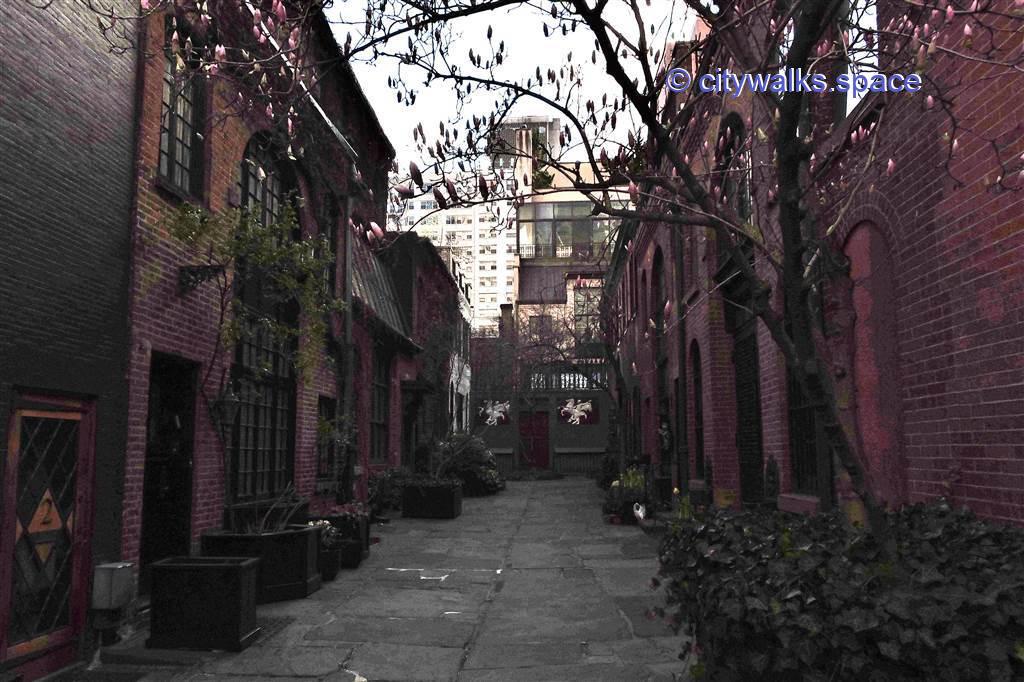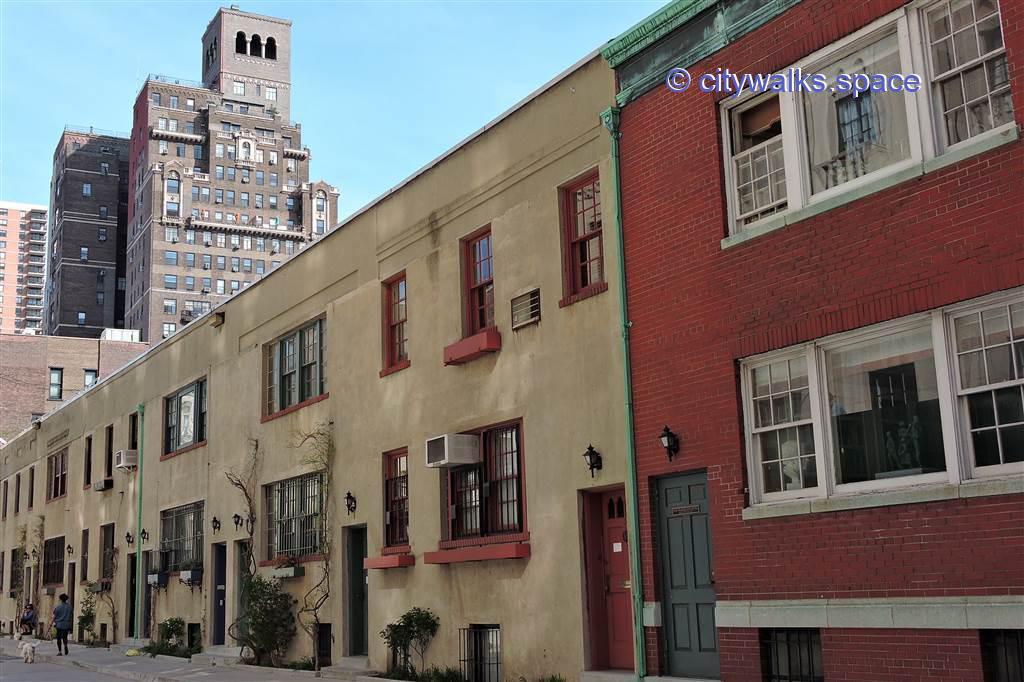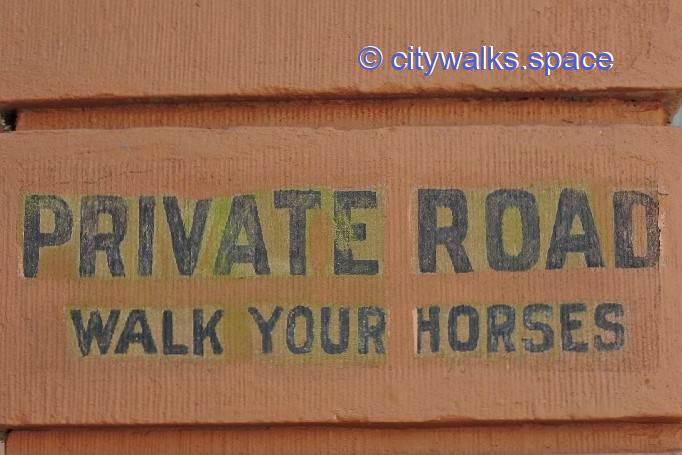
Midtown 
Greenwich Village 
Central Harlem
(texte en français ci-dessous)
Founded in 1624, New York City has not always been swarmed with yellow taxis prowling in between the vertical walls of skyscrapers.
It had its days of horse-drawn carts and while there are still a few that take tourists around Central Park, there have been many more at one time and throughout the city.
So it took a lot of stables to house and feed these horses when they weren’t working and there are still a few scattered around Manhattan.
However, it is no longer horses that live there. The places have kept their character but now house apartments often on one level, a luxury in the city. They are also protected by gates preventing access to the curious who would no doubt like to be photographed in front of the old NYC mews!
Never mind, you can still see them if you follow one of these 3 Walks in NYC.
The first one titled Midtown East Side, Walk in NYC # 8 takes you pretty far off the beaten path and it will be towards the end, when you come back to Grand Central, that you’ll find Sniffen Court.
One of the smallest Historic Districts in town, Sniffen Court houses 10 two-story stables built in 1863-64. In the 1920s, these stables were converted into artist apartments and studios. Two even became a small theater that is still in operation, the Amateur Comedy Club.
The second walk, Discovering Greenwich Village: Walk in NYC # 10, passes through Washington Mews, north of Washington Park.
In 1801, the owner of the farm that was there gave his land to establish retirement homes for former sailors but his will was contested so that when the institution took possession of the land, this part of Manhattan s was so developed that it was more profitable to lease it and establish the retreat institute on Staten Island.
This was what was done and the Victorian-style mansions that were built there, those overlooking on Washington Square, were built with their stables at the back.
In 1912, the institution remodeled these stables into artists’ studios and in the 1950s, New York University bought them to house some of its teachers.
This is what you see today behind the gate which was built by the city in 1881 and replaced by the university in 1988 to clearly differentiate this private complex from the adjacent streets.
The third row of stables is further north and you will find it by following From East Harlem to Central Harlem: Walk in NYC # 13.
It is part of the architectural ensemble of Strivers Row (or St Nicholas Historic District) which was built in 1891-93 to offer luxury housing for the white upper middle classes in a neighborhood reserved for them. The stables were located behind the buildings in interior courtyards.
The project was unsuccessful as whites preferred to move to the suburbs and for decades developers refused to sell to blacks. It was only when they changed their mind that the place was dubbed ‘Striver’s Row’ because it attracted the most affluent population of Harlem, those who had succeeded.
Today the inner courtyards serve as parking lots but the signs Walk Your Horses are still there!
Fondée en 1624, New York n’a pas toujours été envahies de taxis jaunes circulant au milieu des murs verticaux des gratte-ciels.
Elle a eu son époque des carrioles à chevaux et s’il en reste encore quelques-unes qui promènent les touristes autour de Central Park, il y a en eu bien plus dans toute la ville.
Il fallait donc bien des écuries pour abriter et nourrir ces chevaux quand ils ne travaillaient pas et il en reste quelques-unes dispersées dans Manhattan.
Ce ne sont cependant plus des chevaux qui y habitent. Les endroits ont gardé leur caractère mais abritent maintenant des appartements souvent de plein-pied, un luxe dans la ville.
Ils sont aussi protégés par des grilles en interdisant l’accés aux curieux qui aimeraient sans doute se faire photographier devant des anciennes écuries!
Qu’à cela ne tienne, vous pouvez cependant encore les voir si vous suivez une de ces 3 Promenades à NYC.
La première intitulée Midtown coté Est, promenade à NYC numéro 8 vous emmène assez loin des sentiers battus et ce sera vers la fin, quand vous revenez vers Grand Central, que vous trouverez Sniffen Court.
Un des plus petits District Historique de la ville, Sniffen Court abrite 10 écuries de deux étages construite en 1863-64. Dans les années 1920, ces écuries furent converties en appartements et studios d’artistes. Deux devinrent même un petit théâtre qui est toujours en activité, the Amateur Comedy Club.
La deuxième promenade, A la découverte de Greenwich Village: promenade à NYC n° 10, passe par Washington Mews, au nord de Washington Park.
En 1801, le propriétaire de la ferme qui se trouvait à cet endroit donna ses terres pour qu’y soient établies des maisons de retraite pour anciens marins mais son testament fut contesté si bien qu’au moment où l’institution put prendre possession du terrain, cette partie de Manhattan s’était si développée qu’il était plus rentable de louer et d’établir l’institut de retraite sur Staten Island.
C’est ce qui fut fait et les maisons bourgeoises de style victorien qui furent construites à cet endroit, celles donnant sur la place Washington, furent construite avec leurs écuries sur l’arrière.
En 1912, l’institution fit remodeler ces écuries en studios d’artistes et dans les années 1950, l’université de New York les racheta pour loger certains de ses enseignants. C’est ce que vous voyez aujourd’hui derriere la grille qui fut construite par la ville en 1881 puis remplacée par l’université en 1988 pour bien différencier cet ensemble privé des rues adjacentes.
La troisème rangée d’écuries se trouve plus au nord de la ville et vous la trouverez en suivant De East Harlem à Central Harlem: Promenade à NYC numéro 13.
Elle fait partie de l’ensemble architectural de Strivers Row (ou St Nicholas Historic District) qui avait été construit en 1891-93 pour offrir aux classes moyennes supérieures blanches des logements de luxe dans un quartier leur étant réservé. Les écuries étaient situées à l’arrière des bâtiments dans des cours intérieures.
Le projet fut un échec car les blancs préférèrent partir dans la banlieue et pendant des décennies, les promoteurs ne voulurent pas vendre aux noirs. Ce ne fut que quand ils changèrent d’avis que l’endroit fut surnommé ‘Striver’s Row” car il attira la partie la plus affluente des habitants de Harlem, ceux qui avaient réussi.
Aujourd’hui, les cours intérieures servent de parking mais les signes indiquant de mener les chevaux au pas sont encore là!
Pauline Harris